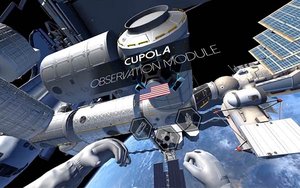 NASA’s Kennedy Space Center Visitor Complex in Florida just launched three virtual reality experiences in an effort to appeal to younger demographics and increase general interest in
space.
NASA’s Kennedy Space Center Visitor Complex in Florida just launched three virtual reality experiences in an effort to appeal to younger demographics and increase general interest in
space.
The three experiences include a virtual space walk around the International Space Station, an educational tour of the solar system and a virtual tour of the Space Center Visitor Complex
itself.
Each experience is contained within an individual smartphone app that works in conjunction with custom-branded NASA VR headsets, dubbed ‘Space Visors,’ which are
purchasable online or in the giftshop at the complex. The experiences were developed by Florida-based brandVR.
“This was really intended to be something that would allow the visitors to
be able to take a piece of space back home with them,” Mahmoud Mattan, co-founder and CEO of brandVR, told the IoT Daily.
advertisement
advertisement
“We worked with physicists and astronauts at NASA to make
sure everything that we showed in the experience was actually true,” Mattan said.
The goal of this campaign and reason for using VR and immersive experiences is to attract younger
demographics to increase their excitement for space, according to Mattan.
“Kennedy Space Center was having a huge problem attracting the youth to the Space Center; there was sort of an
age gap that you would see when you would go to the Space Center,” Mattan told the IoT Daily.
After sending a team of game developers to do an audit of the Kennedy Space Center, using
virtual reality as the platform was determined to be the best route, mostly due to its immersive and engaging nature, Mattan said.
The experiences are interactive, to a degree. The headsets
don’t have any physical controllers or triggers, which are common in other mobile-based VR viewers. Rather, the experiences utilize so-called gaze UI, which triggers interactive elements when
the user pauses on content for a certain period of time.
Kiosks with the headsets are located throughout the complex for visitors to get a sense of the experience, in addition to offering the
headsets for purchase at the gift shop.
Two of the experiences are fully computer generated VR and the virtual tour of Kennedy Space Center utilizes a combination of CGI content and 360 photo
and video content captured at the Space Center.
Integrating VR and AR into marketing efforts, especially for experiential activations, is going to become more popular with brands moving
forward, according to Mattan.
“Virtual reality and augmented reality, these technologies are really going to be influential this year as the headsets are getting more adoption and brands
are willing to spend a little bit more money on this sort of experiential marketing,” Mattel told the Daily.
“You’ve seen a lot of brands kind of dipping their toes in it and
they’ve seen some early success,” he said. “Eventually, I think we’ll see full-on AR/VR marketing teams inside companies.”